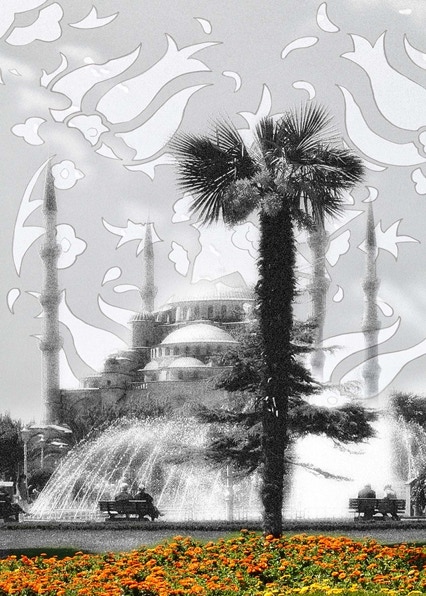-
CUT PAPER
-
PHOTOGRAPHY
-
OTHER WORK

In the Ottoman Garden, 2005-09
Ottoman embroideries inspire this body of work. Commonplace throughout the Empire, decorative needlework transformed household basics into items of beauty. Men, women and children stitched them. Europeans collected them. Many embroideries depict stylized flowers, reflecting the Ottoman penchant for the garden. By adapting their designs I re-imagine the garden.
The Ottoman Garden
In the Islamic world, a garden is an earthly paradise. In the harsh, hot climate of Anatolia, as in the Middle East, it is fabricated against the odds. It offers an oasis.
The Ottomans were obsessed with gardens and flowers. Both Turks and European travelers to Turkey record their experiences in these installations. Gardens consisted of flowers, trees and fountains, and gazebos and kiosks from which to view them.
Flowers included tulip, hyacinth and carnation, as well as pomegranate, rose, iris, narcissus and anemone. Tulips were most coveted. During the 1560s, Sultan Selim II ordered 300,000 tulip bulbs from the Crimea for his gardens at the Topkapi. Flowers grown at the palace were sold at markets throughout Istanbul. At one time this city was home to 80 flower shops and 300 florists.
Foreigners were taken by the selection available in Istanbul. By the late 16th c. flowers were traded with Vienna and with northern Italy. During the peak trade period in the 1630s, known as Tulip-Mania in the Netherlands, tulips were the fourth leading export product of the Dutch East Indies trade. By the so-called Tulip Period (1703-30), about 2,000 varieties of tulips had been cultivated in Turkey, some so valued that the Imperial Court gave them as gifts commensurate with jewels.
Court Style of the Ottoman Garden
In the latter 16th century the Ottomans reinvented the concept of the garden. Specifically, they translated it from outdoor feature to one of primary placement in interior space. Associated with the court style of Sultan Suleiman the Magnificent, this change is attributed to the workshop of the artist Kara Memi.
Three attributes define this workshop’s style. First, by choosing floral favorites of the Ottomans, it created an iconography specific to Turkish art. Second, it designed stylized and hybridized representations of flowers whose combinations gave the effect of a wild garden or mixed bouquet. Finally, with Kara Memi, flowers took center stage in the principle field of decoration in all art forms.
Process and Memory
Ottoman decorative arts are replete with imagery of gardens and flowers. An integral part of daily life, embroideries were made for every use: bed covers, cushions, curtains, covers for special clothing, sashes, pants and blouses and towels and napkins. They were produced at the court, in workshops and at home. Men, women and girls created them. Historically, imagery was drawn in ink or applied to textiles by means of cut paper patterns. Similar to memory, no two embroideries were the same, regardless how often an image or pattern was replicated.
Like the act of stitching, my process is about repetition and reiteration. I begin by making transparencies of patterns. I project them and separate out layers. I fabricate templates of trace paper. Laying paper over paper, I cut and reshape. My process continually changes. At times I work with the bare lines of a motif. At others I embellish with ink. At still others I intentionally blur the boundaries to give the viewer opportunity to fill in.
Photography from the Garden
Cropped black and white images represent details of my floral cutwork. Excerpts, they read as bouquets. I print these onto cotton rag to reference fibers of embroidery. In the color photograph, the tulip cutwork is superimposed over my image of the Sultan Ahmed Mosque.
In the collection of Fidelity Investments.
Thin Air, 2007
An installation, Thin Air comprises 19 sheets of illuminated hand-cut vellum. For this work I adapted an Ottoman embroidery pattern incorporating both flowers and elements of an Eastern Wheel of Life. I integrate cuts representing ripples and bubbles of water, which, like fountains, obscure. It becomes a landscape imagined.
The viewer passes through tapestries of shadows. Weaving in and out of focus, images mesmerize. By reinterpretation, one experiences a garden.